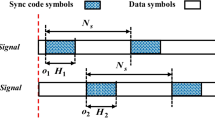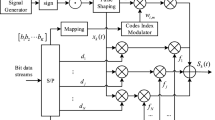Abstract
There are considered the aspects of application of modulation technique called Cyclic Code Shift Keying (CCSK) and signals processing in different communication applications, such as LPI, satellite navigation, deep space communication, TDCS technique, IoT networks, etc. On a basis of selection of principally new (“complementary”) basis function we state and solve the problem of development of modulation/demodulation technique combining processing simplicity, which is specific for the signals with cyclic structure, noise immunity, specific to orthogonal systems. The estimation of computational cost gain in compare to known orthogonal modulation method and noise immunity gain regarding traditional CCSK allows to define limitary technical parameters where obtained results are advisable to be used. A length of “spectrum spreading” sequences in this case is from N = 64 to N = 1024 covering whole range of practically valuable values. Obtained results allow to essentially extend the term of autonomous operation of low-power devices of the internet of things, increase of energy budget of radiolines in deep space communication systems, make possible the reception of the signals with ultra wide basis in communication systems with increased requirements to energy and structural security.






Similar content being viewed by others
Notes
In particular case, correlations of signals based on the Walsh code can be calculated by finding the Hadamard metrics using a butterfly algorithm [4], where savings in computations are achieved by reusing previously obtained partial correlations common to all reference copies. However, this is only possible for signals based on Hadamard matrices with a fixed (and therefore easily predictable) structure that do not provide the necessary structural secrecy.
References
A. J. Viterbi, Principles of Coherent Communication (McGraw-Hill Inc., 1966). URI: https://www.amazon.com/Principles-Coherent-Communication-Viterbi/dp/0070675155.
C. L. Grasse, "JTIDS modular design to use SAW devices," in Proceedings of International Telemetering Conference (International Foundation for Telemetering, 1977). URI: https://repository.arizona.edu/handle/10150/609741?show=full.
G. M. Dillard, M. Reuter, J. Zeiddler, B. Zeidler, "Cyclic code shift keying: a low probability of intercept communication technique," IEEE Trans. Aerosp. Electron. Syst., v.39, n.3, p.786 (2003). DOI: https://doi.org/10.1109/TAES.2003.1238736.
A. J. Viterbi, CDMA: Principles of Spread Spectrum Communication (Pearson, 1995). URI: http://www.amazon.com/exec/obidos/ASIN/0201633744/ref=nosim/eslisbn-20.
R. Roberts, The ABCs of Spread Spectrum - A Tutorial. URI: http://sss-mag.com/ss.html.
Y. Yang, L. Zhu, X. Mao, Q. Tan, Z. He, "The spread spectrum GFDM schemes for integrated satellite-terrestrial communication system," China Commun., v.16, n.12, p.165 (2019). DOI: https://doi.org/10.23919/JCC.2019.12.013.
S. Ma, X. Li, D. Zou, "A CCSK based navigation and communication integrated satellite signal," in 2021 International Wireless Communications and Mobile Computing (IWCMC) (IEEE, 2021). DOI: https://doi.org/10.1109/IWCMC51323.2021.9498883.
A. J. Garcia-Peña, M. Aubault-Roudier, L. Ries, M.-L. Boucheret, C. Poulliat, O. Julien, "Code shift keying: Prospects for improving GNSS signal designs," Insid. GNSS, v.10, n.6, p.52 (2015). URI: https://hal.archives-ouvertes.fr/hal-02533723.
K. Saied, A. C. Al Ghouwayel, E. Boutillon, "Time-synchronization of CCSK short frames," in 2021 17th International Conference on Wireless and Mobile Computing, Networking and Communications (WiMob) (IEEE, 2021). DOI: https://doi.org/10.1109/WiMob52687.2021.9606328.
S. M. Killough, M. M. Olama, T. Kuruganti, "Gold code-phase-shift keying: a power and bandwidth efficient communication scheme for smart buildings," in 2018 IEEE International Workshop Technical Committee on Communications Quality and Reliability (CQR) (IEEE, 2018). DOI: https://doi.org/10.1109/CQR.2018.8445903.
M.-L. Ku, W. Li, Y. Chen, K. J. Ray Liu, "Advances in energy harvesting communications: past, present, and future challenges," IEEE Commun. Surv. Tutorials, v.18, n.2, p.1384 (2016). DOI: https://doi.org/10.1109/COMST.2015.2497324.
X. Da, Y. Liang, H. Hu, R. Xu, L. Ni, D. Zhai, Y. Pan, "Embedding WFRFT signals into TDCS for secure communications," IEEE Access, v.6, p.54938 (2018). DOI: https://doi.org/10.1109/ACCESS.2018.2872936.
I. A. Gepko, "Correlation properties and statistical characteristics of periodic complementary sequences," Izv. Vyss. Uchebnykh Zaved. Radioelektronika, v.38, n.8, p.36 (1995).
I. A. Gepko, A. V. Bessalov, "Synthesizing two classes of maximum-size orthogonal nonlinear codes," Izv. VUZ Radioelektronika, v.36, n.12, p.26 (1993).
C.-H. Kao, C. Robertson, K. Lin, "Performance analysis and simulation of cyclic code-shift keying," in MILCOM 2008 - 2008 IEEE Military Communications Conference (IEEE, 2008). DOI: https://doi.org/10.1109/MILCOM.2008.4753273.
M. B. Pursley, T. C. Royster, M. Y. Tan, "High-rate direct-sequence spread spectrum," in IEEE Military Communications Conference, 2003. MILCOM 2003. (IEEE, 2003). DOI: https://doi.org/10.1109/MILCOM.2003.1290331.
L. Y. Varakin, Communication Systems with Noise-like Signals (Radio i Svyaz’, Moscow, 1985).
K. H. A. Karkkainen, "Mean-square cross-correlation as a performance measure for department of spreading code families," in IEEE Second International Symposium on Spread Spectrum Techniques and Applications (IEEE, 1992). DOI: https://doi.org/10.1109/ISSSTA.1992.665668.
T. A. Gulliver, "Matching Q-ary Reed-Solomon codes with M-ary modulation," IEEE Trans. Commun., v.45, n.11, p.1349 (1997). DOI: https://doi.org/10.1109/26.649739.
E. R. Berlekamp, "The technology of error-correcting codes," Proc. IEEE, v.68, n.5, p.564 (1980). DOI: https://doi.org/10.1109/PROC.1980.11696.
Author information
Authors and Affiliations
Corresponding author
Ethics declarations
ADDITIONAL INFORMATION
I. A. Gepko
The authors declare that they have no conflicts of interest.
This article does not contain any studies with human participants or animals performed by any of the authors.
The initial version of this paper in Russian is published in the journal “Izvestiya Vysshikh Uchebnykh Zavedenii. Radioelektronika,” ISSN 2307-6011 (Online), ISSN 0021-3470 (Print) on the link http://radio.kpi.ua/article/view/S0021347022020017 with DOI: https://doi.org/10.20535/S0021347022020017
Additional information
Translated from Izvestiya Vysshikh Uchebnykh Zavedenii. Radioelektronika, No. 2, pp. 71-83, February, 2022 https://doi.org/10.20535/S0021347022020017 .
About this article
Cite this article
Gepko, I.A. Orthogonal CCSK Based on Complementary Code Sequences. Radioelectron.Commun.Syst. 65, 61–71 (2022). https://doi.org/10.3103/S0735272722020017
Received:
Revised:
Accepted:
Published:
Issue Date:
DOI: https://doi.org/10.3103/S0735272722020017




